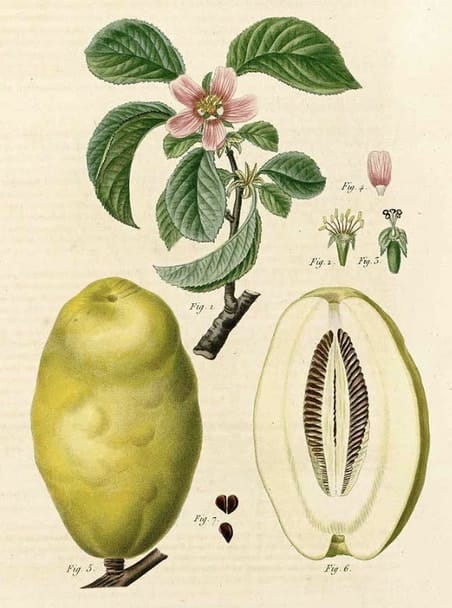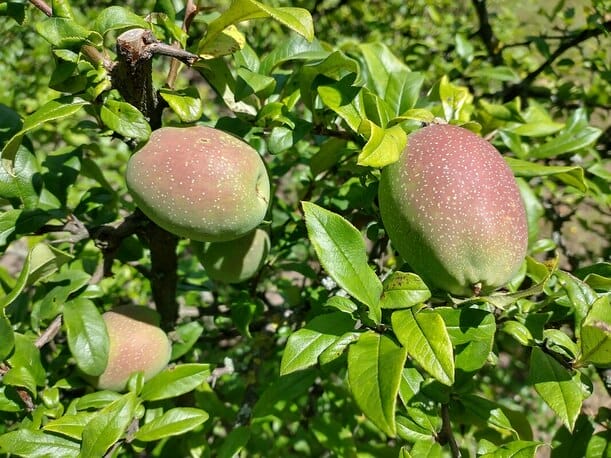Chaenomeles, Chinese Quince, Mu Gua 木瓜
Chinese Quince, Flowering Quince, ChaenomelesMu Gua (TCM)
Bse yab བསེ་ཡབ (Tibetan)
 Duhamel du Monceau, H.L., Traité des arbres et arbustes, 1815
Duhamel du Monceau, H.L., Traité des arbres et arbustes, 1815 Chaenomeles speciosa
Chaenomeles speciosa(Photo by MOs810) (Wikimedia)
Botanical name:
Chaenomeles spp.
- C. lagenaria
- C. speciosa (Bengal Quince)
- C. sinensis (Chinese Quince)
Parts used:
Fruit
Temperature & Taste:
Warm, dry. Sour, Sweet (Cool in Tibetan Medicine)
Classification:
D. Clear Wind and Damp
Uses:
1. Harmonises the Stomach, Clears Damp: (TCM, Tibet, Ayurveda)
-poor appetite, indigestion, vomiting, diarrhea
-abdominal pain and cramping
-chronic Stomach disorders including Ulcers in Tibetan Medicine
2. Clears Phlegm and Damp: (TCM, Ayurveda)
-Damp obstructing Stomach or Abdomen
-Edema, Swelling of the Legs
3. Resolves Food Stagnation: (TCM, Tibet)
-Indigestion with foul breath and coated tongue from Food Stagnation
-used for Dark Phlegm in Tibetan Medicine
4. Relaxes the Sinews, Clears Obstructions of the Channels: (TCM, Tibet, Ayurveda)
-Pain, weakness or cramping of the lower back and lower limbs
-numbness, atrophy or hypertonicity of the sinews and ligaments
-Wind-Damp painful obstruction; Arthritis, Ankylosis
-Ear disorders (loss of hearing, tinnitus) in Tibetan Medicine
Dose:
Decoction: 6–12 grams
Preparation:
1. It is washed, steamed, cut into thin slices, then sun-dried
Substitutes:
1. In Tibetan Medicine, Mango fruit is viewed as a suitable substitute for Bse yab.
2. The western Quince may be used similarly, especially for Stomach disorders.
Main Combinations:
1. Damp obstructing the Stomach, Chaenomeles Mu Gua with Amomum Sha Ren and Pogostemon Huo Xiang.
2. Abdominal fullness, epigastric pain, indigestion, vomiting, Chebula, Calcite, Pterocephalus, Shilajit, Inula, Chaenomeles Mu Gua, Pomegranate fruit,
3. Cramps or Spasms due to Blood deficiency, Chaenomeles Mu Gua with Dang Gui, Paeonia Bao Shao, Licorice
4. Weakness, atrophy and joint pain in the lower limbs, Chaenomeles Mu Gua with Angelica Du Huo
5. Weakness and aching in the lower back, numbness and contracture of the limbs:
i. Chaenomeles Mu Gua with Dang Gui, Paeonia Bai Shao, Eucommia Du Zhong, Dipsacus Xu Duan, Frankincense (as in Miao Ji Wan)
ii. Chaenomeles Mu Gua with Dang Gui, Angelica dahurica Bai Zhi, Achyranthes Niu Xi, Ginseng, Aconitum Fu Zi (as in Mu Gua Wan)
iii. Chaenomeles Mu Gua with Saposhnikovia Fang Feng, Cinnamon twig (Gui Zhi), Ephedra Ma Huang, Aconitum Fu Zi, Atractylodes Bai Zhu, Achyranthes Niu Xi, Licorice (as in Qu Feng Shu Jin Wan)
iv. Chaenomeles Mu Gua with prepared Nux Vomica (Ma Qian Zi), Ephedra Ma Huang, Frankincense (vinegar-prepared), Myrrh (vinegar-prepared), Cinnamon twig (Gui Zhi), Achyranthes Niu Xi, Saposhnikovia Fang Feng, Eucommia Du Zhong (salt-prepared), Licorice (as in Shu Feng Ding Tong Wan of the Chinese Pharmacopoeia)
6. Wind-Damp painful obstruction:
i. Chaenomeles Mu Gua with Aconitum Fu Zi, Safflower (Hong Hua), Licorice, Ephedra Ma Huang (as in Feng Shi Gu Tong Jiao Nang of the Chinese Pharmacopoeia)
7. Edema from Yang deficiency, Chaenomeles Mu Gua with Aconitum Fu Zi, Ginger, Poria Fu Ling, Atractylodes Bai Zhu, Costus, Amomum tsaoko Cao Guo, Licorice (as in Shi Pi Yin)
Major Formulas:
Bu Gan Tang
Feng Shi Gu Tong Jiao Nang
Guo Gong Jiu
Jie Bai Wan
Liu He Ding Zhong Wan
Miao Ji Wan
Mu Gua Wan
Mu Xiang Liu Qi Yin
Ping Gan Shu Luo Wan
Qu Feng Shu Jin Wan
Shi Pi Yin
Shu Feng Ding Tong Wan
Shu Jin Huo Luo Jiu
Si Zheng Wan
Wen Yang Bu Gan Jian
Zhui Feng Huo Xue Pian
Licorice 6 (Shing mngar drug pa) (Tibetan)
Cautions:
1. Not used in those with dark, scanty Urine.
2. Excess use damages teeth and bones.
